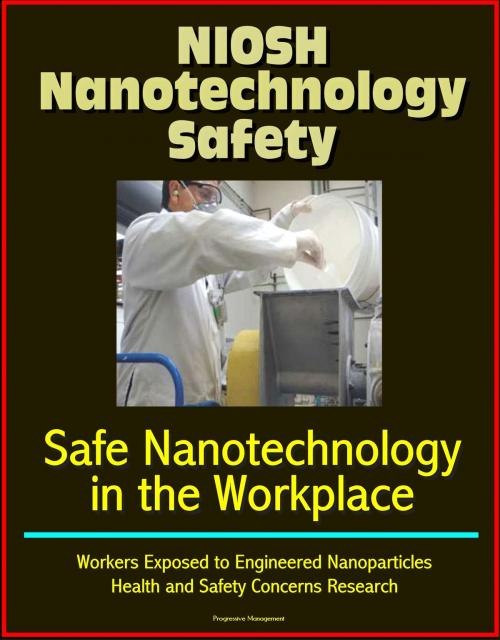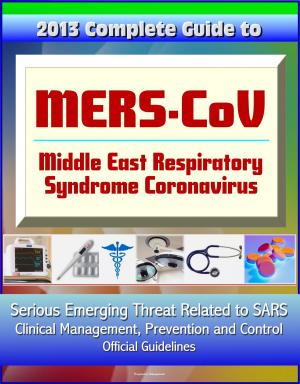NIOSH Nanotechnology Safety: Safe Nanotechnology in the Workplace, Workers Exposed to Engineered Nanoparticles, Health and Safety Concerns Research
Nonfiction, Science & Nature, Technology, Nanotechnology| Author: | Progressive Management | ISBN: | 9781301622894 |
| Publisher: | Progressive Management | Publication: | May 31, 2013 |
| Imprint: | Smashwords Edition | Language: | English |
| Author: | Progressive Management |
| ISBN: | 9781301622894 |
| Publisher: | Progressive Management |
| Publication: | May 31, 2013 |
| Imprint: | Smashwords Edition |
| Language: | English |
Comprehensive documents from the National Institute for Occupational Safety and Health (NIOSH) provide thorough coverage of workplace safety issues involving nanotechnology and nanoparticles.
Nanotechnology is the engineering and manipulation of materials at the molecular level. This new technology creates materials with dimensions ranging from 1 to 100 nanometers (1 nanometer is 1 billionth of a meter). Particles created at the nanoscale have different chemical and physical properties than larger particles of the same material. These manufactured nanoparticles are known as engineered nanoparticles. Scientists and manufacturers can use nanoparticles to create new products that would be impossible with larger particles. Are nanoparticles hazardous to workers? How can workers be exposed? Can nanoparticles be measured? Can worker exposures be controlled? Little information is available about the hazards of nanoparticles in the workplace. The National Institute for Occupational Safety and Health (NIOSH) is conducting research to determine whether they pose a health threat to exposed workers. Different types of nanoparticles are made or used in various industrial processes. To determine whether these nanoparticles pose a hazard to workers, scientists must know the following: Types and concentrations of nanoparticles in the workplace; Properties of nanoparticles that could affect the body; Concentrations of nanoparticles that could produce adverse effects. Laboratory studies in animals have shown that some types of nanoparticles may reach the blood, brain, and other organs of laboratory animals when they are inhaled. Some studies have shown adverse effects such as inflammation and fibrosis in the lungs and other organs of animals. Human studies of exposure and response to engineered nanoparticles are not currently available.
Traditional industrial hygiene sampling methods can be used to measure airborne nanoparticles. However, these methods are limited and require careful interpretation. Scientists are developing more sensitive and specific sampling techniques to evaluate occupational exposures to nanoparticles.
Sampling in the workplace should include background measurements and measurements before, during, and after production or handling of nano-particles. These measurements can determine if emissions and possible exposures are occurring.
Employers should use engineering controls to reduce worker exposures to nanoparticles. These controls include source enclosure (isolating the generation source from the worker) and local exhaust ventilation systems. Exhaust ventilation systems that use high-efficiency particulate air (HEPA) filters are very effective in removing nanoparticles. Engineering controls have been designed to reduce worker exposures to other particles with sizes similar to those of nanoparticles. Examples include controls for welding fume. These controls are also effective for the manufacturing and fabrication of nanoparticles. Respirators should be considered if engineering and administrative controls do not control worker exposures to nanoparticles. The decision to use respirators should be based on professional judgment and an assessment of worker exposures and the health risks they pose. Worker training should be part of any complete safety and health program. To reduce nanoparticle exposures, workers should learn how to safely handle nanoparticles, use personal protective equipment, handle work clothes, clean contaminated surfaces, and dispose of spilled nanoparticles.
Comprehensive documents from the National Institute for Occupational Safety and Health (NIOSH) provide thorough coverage of workplace safety issues involving nanotechnology and nanoparticles.
Nanotechnology is the engineering and manipulation of materials at the molecular level. This new technology creates materials with dimensions ranging from 1 to 100 nanometers (1 nanometer is 1 billionth of a meter). Particles created at the nanoscale have different chemical and physical properties than larger particles of the same material. These manufactured nanoparticles are known as engineered nanoparticles. Scientists and manufacturers can use nanoparticles to create new products that would be impossible with larger particles. Are nanoparticles hazardous to workers? How can workers be exposed? Can nanoparticles be measured? Can worker exposures be controlled? Little information is available about the hazards of nanoparticles in the workplace. The National Institute for Occupational Safety and Health (NIOSH) is conducting research to determine whether they pose a health threat to exposed workers. Different types of nanoparticles are made or used in various industrial processes. To determine whether these nanoparticles pose a hazard to workers, scientists must know the following: Types and concentrations of nanoparticles in the workplace; Properties of nanoparticles that could affect the body; Concentrations of nanoparticles that could produce adverse effects. Laboratory studies in animals have shown that some types of nanoparticles may reach the blood, brain, and other organs of laboratory animals when they are inhaled. Some studies have shown adverse effects such as inflammation and fibrosis in the lungs and other organs of animals. Human studies of exposure and response to engineered nanoparticles are not currently available.
Traditional industrial hygiene sampling methods can be used to measure airborne nanoparticles. However, these methods are limited and require careful interpretation. Scientists are developing more sensitive and specific sampling techniques to evaluate occupational exposures to nanoparticles.
Sampling in the workplace should include background measurements and measurements before, during, and after production or handling of nano-particles. These measurements can determine if emissions and possible exposures are occurring.
Employers should use engineering controls to reduce worker exposures to nanoparticles. These controls include source enclosure (isolating the generation source from the worker) and local exhaust ventilation systems. Exhaust ventilation systems that use high-efficiency particulate air (HEPA) filters are very effective in removing nanoparticles. Engineering controls have been designed to reduce worker exposures to other particles with sizes similar to those of nanoparticles. Examples include controls for welding fume. These controls are also effective for the manufacturing and fabrication of nanoparticles. Respirators should be considered if engineering and administrative controls do not control worker exposures to nanoparticles. The decision to use respirators should be based on professional judgment and an assessment of worker exposures and the health risks they pose. Worker training should be part of any complete safety and health program. To reduce nanoparticle exposures, workers should learn how to safely handle nanoparticles, use personal protective equipment, handle work clothes, clean contaminated surfaces, and dispose of spilled nanoparticles.















